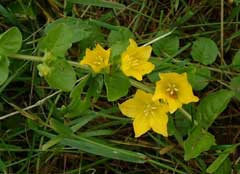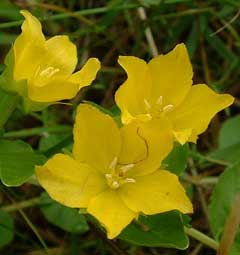 |
|
http://commons.wikimedia.org/wiki/User:Rasbak |
 |
| http://commons.wikimedia.org/wiki/User:Rasbak |
Translate this page:
Summary
Bloom Color: Yellow. Main Bloom Time: Early summer, Late summer, Mid summer. Form: Prostrate, Spreading or horizontal, Variable spread.
Physical Characteristics

 Lysimachia nummularia is an evergreen Perennial growing to 0.2 m (0ft 8in) by 0.6 m (2ft) at a fast rate.
Lysimachia nummularia is an evergreen Perennial growing to 0.2 m (0ft 8in) by 0.6 m (2ft) at a fast rate.
See above for USDA hardiness. It is hardy to UK zone 4. It is in leaf all year, in flower from June to August, and the seeds ripen from August to September. The species is hermaphrodite (has both male and female organs) and is pollinated by Bees, flies. The plant is self-fertile.
Suitable for: light (sandy), medium (loamy) and heavy (clay) soils and can grow in heavy clay soil. Suitable pH: mildly acid, neutral and basic (mildly alkaline) soils. It can grow in semi-shade (light woodland) or no shade. It prefers moist or wet soil and can grow in water.
UK Hardiness Map
US Hardiness Map
Synonyms
Plant Habitats
Ground Cover; Pond; Bog Garden;
Edible Uses
Edible Parts:
Edible Uses: Tea
A tea is made from the leaves and flowers[46, 61, 177, 183].
References More on Edible Uses
Medicinal Uses
Plants For A Future can not take any responsibility for any adverse effects from the use of plants. Always seek advice from a professional before using a plant medicinally.
Antidiarrhoeal Antiscorbutic Astringent Diuretic Vulnerary
The whole herb, used fresh or dried, is antiscorbutic, mildly astringent, diuretic and vulnerary[4, 9, 46]. For drying, the herb is harvested in June[4]. Creeping Jenny is a very good wound-herb, the fresh leaves being bruised and applied externally to the affected area[4]. An infusion is used to treat internal bleeding and diarrhoea[9].
References More on Medicinal Uses
The Bookshop: Edible Plant Books
Our Latest books on Perennial Plants For Food Forests and Permaculture Gardens in paperback or digital formats.

Edible Tropical Plants
Food Forest Plants for Hotter Conditions: 250+ Plants For Tropical Food Forests & Permaculture Gardens.
More

Edible Temperate Plants
Plants for Your Food Forest: 500 Plants for Temperate Food Forests & Permaculture Gardens.
More

More Books
PFAF have eight books available in paperback and digital formats. Browse the shop for more information.
Shop Now
Other Uses
Can be used as a ground cover plant in moist soils but requires weeding for the first year or so. Plants should be spaced about 60cm apart each way and form a carpet, rooting as they spread[208].
Special Uses
Food Forest Ground cover
References More on Other Uses
Cultivation details
Landscape Uses:Container, Ground cover, Rock garden, Woodland garden. An easily grown plant, succeeding in a moist loamy soil[1]. Grows well in heavy clay soils. Grows well in marshy soil and in shallow water in pond margins[24, 56]. Prefers a shady position[111] but also succeeds in full sun[188]. Plants are hardy to at least -25°c[187]. Most species in this genus seem to be immune to the predations of rabbits[233]. A very ornamental plant[1]. Special Features:Attractive foliage, Invasive, Naturalizing, Fragrant flowers, Inconspicuous flowers or blooms.
References Carbon Farming Information and Carbon Sequestration Information
Temperature Converter
Type a value in the Celsius field to convert the value to Fahrenheit:
Fahrenheit:
The PFAF Bookshop
Plants For A Future have a number of books available in paperback and digital form. Book titles include Edible Plants, Edible Perennials, Edible Trees,Edible Shrubs, Woodland Gardening, and Temperate Food Forest Plants. Our new book is Food Forest Plants For Hotter Conditions (Tropical and Sub-Tropical).
Shop Now
Plant Propagation
Seed - sow spring or autumn in a cold frame[200]. This species rarely produces seed in Britain[17]. When they are large enough to handle, prick the seedlings out into individual pots and plant them out in the summer. Division in spring or autumn[200]. Larger clumps can be replanted direct into their permanent positions, though it is best to pot up smaller clumps and grow them on in a cold frame until they are rooting well. Plant them out in the spring.
Other Names
If available other names are mentioned here
Native Range
TEMPERATE ASIA: Turkey, Russian Federation-Ciscaucasia (Ciscaucasia) EUROPE: Denmark, United Kingdom, Ireland, Austria, Switzerland, Czech Republic, Germany, Hungary, Netherlands, Poland, Slovakia, Russian Federation (European part), Estonia, Lithuania, Latvia, Moldova, Ukraine (incl. Krym), Albania, Bulgaria, Greece, Croatia, Italy, Romania, Serbia, Slovenia, Spain, France
Weed Potential
Right plant wrong place. We are currently updating this section.
Please note that a plant may be invasive in one area but may not in your area so it's worth checking.
Conservation Status
IUCN Red List of Threatened Plants Status :

Growth: S = slow M = medium F = fast. Soil: L = light (sandy) M = medium H = heavy (clay). pH: A = acid N = neutral B = basic (alkaline). Shade: F = full shade S = semi-shade N = no shade. Moisture: D = dry M = Moist We = wet Wa = water.
Now available:
Food Forest Plants for Mediterranean Conditions
350+ Perennial Plants For Mediterranean and Drier Food Forests and Permaculture Gardens.
[Paperback and eBook]
This is the third in Plants For A Future's series of plant guides for food forests tailored to
specific climate zones. Following volumes on temperate and tropical ecosystems, this book focuses
on species suited to Mediterranean conditions—regions with hot, dry summers and cool, wet winters,
often facing the added challenge of climate change.
Read More
Expert comment
Author
L.
Botanical References
17200
Links / References
For a list of references used on this page please go here
Readers comment
| Add a comment |
|
If you have important information about this plant that may help other users please add a comment or link below. Only comments or links that are felt to be directly relevant to a plant will be included. If you think a comment/link or information contained on this page is inaccurate or misleading we would welcome your feedback at [email protected]. If you have questions about a plant please use the Forum on this website as we do not have the resources to answer questions ourselves.
* Please note: the comments by website users are not necessarily those held by PFAF and may give misleading or inaccurate information.
To leave a comment please Register or login here All comments need to be approved so will not appear immediately.
|
Subject : Lysimachia nummularia
|
|
|
|